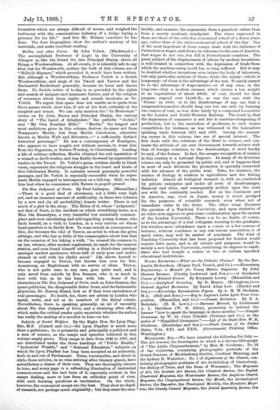The New Judgment of Paris. By Paul Lafargue. (Macmillan.) —There
is a good deal of cleverness, not a little very high art, and an immense amount of artificiality, in these two volumes by a new and (in all probability) female writer. There is not much of a plot in the story. The Helen of it, whose "judgment," not that of Paris, is the incident on which everything turns, is a Miss Ida Bannatyne, a very beautiful but essentially common- place and even calculating and self-regarding young woman, who finds herself, on a visit to London, in a very curious set whose head-quarters is in Savile Row. To some extent in consequence of this, she becomes the idol of Trevor, an artist to whom she gives sittings, and who has so little of the commonplace about him that on the occasion of his taking a walk, "he crossed the common to an inn, whence, after modest regalement, he made for the nearest station, and soon found himself sitting in a third-class carriage amongst market gardeners, whose talk of early peas and endive chimed in well with his idyllic mood." Ida allows herself to become engaged to Trevor, but throws him over for Eric Armstrong, an Englishman with no nerves or ideas. Trevor, who is not quite sane in any case, goes quite mad, and is only saved from suicide by Eva Sumner, who is as much in love with him as he has been with Ida. Some of the characters in The New Judgment of Paris, such as John Sumner, the quasi-politician, the disagreeable Sister Irene, and the fashionable physician, Dr. Harvey Bland, look as if they were caricatures of real personages. No doubt, too, there are artists in London who speak, write, and act as do members of the Byleaf coterie. Nevertheless, there is, speaking generally, an air of unreality about The New Judgment of Paris, and a straining after effect, which make the critical reader quite uncertain whether the author has really the making of a novelist in him—or her.


































 Previous page
Previous page